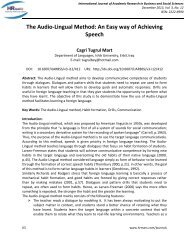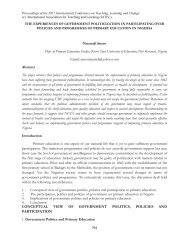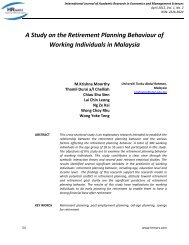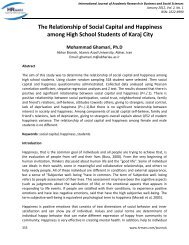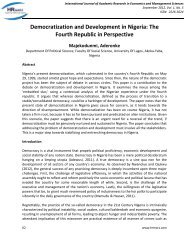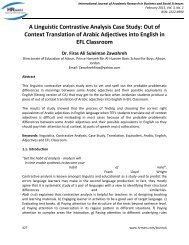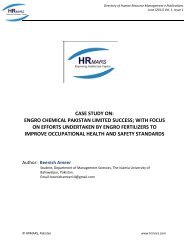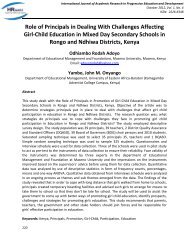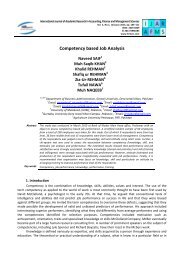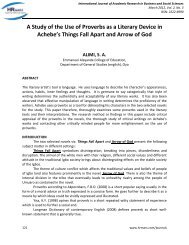Impact of Peer Pressure and Store Atmosphere on Purchase ...
Impact of Peer Pressure and Store Atmosphere on Purchase ...
Impact of Peer Pressure and Store Atmosphere on Purchase ...
Create successful ePaper yourself
Turn your PDF publications into a flip-book with our unique Google optimized e-Paper software.
Internati<strong>on</strong>al Journal <str<strong>on</strong>g>of</str<strong>on</strong>g> Academic Research in Business <str<strong>on</strong>g>and</str<strong>on</strong>g> Social Sciences<br />
July 2012, Vol. 2, No. 7<br />
ISSN: 2222-6990<br />
<str<strong>on</strong>g>Impact</str<strong>on</strong>g> <str<strong>on</strong>g>of</str<strong>on</strong>g> <str<strong>on</strong>g>Peer</str<strong>on</strong>g> <str<strong>on</strong>g>Pressure</str<strong>on</strong>g> <str<strong>on</strong>g>and</str<strong>on</strong>g> <str<strong>on</strong>g>Store</str<strong>on</strong>g> <str<strong>on</strong>g>Atmosphere</str<strong>on</strong>g> <strong>on</strong><br />
<strong>Purchase</strong> Intenti<strong>on</strong>: An Empirical Study <strong>on</strong> the<br />
Youngsters in Pakistan<br />
Ms. Fatima Gillani<br />
Lecturer, Institute <str<strong>on</strong>g>of</str<strong>on</strong>g> Business & Management, University <str<strong>on</strong>g>of</str<strong>on</strong>g> Engineering <str<strong>on</strong>g>and</str<strong>on</strong>g> Technology,<br />
Lahore, Pakistan<br />
Email: gillani.fatima@gmail.com<br />
Abstract<br />
In any business the most important asset for the success is the “c<strong>on</strong>sumer”, they are the factors<br />
<str<strong>on</strong>g>of</str<strong>on</strong>g> sale <str<strong>on</strong>g>and</str<strong>on</strong>g> pr<str<strong>on</strong>g>of</str<strong>on</strong>g>its <str<strong>on</strong>g>of</str<strong>on</strong>g> the business. Knowing <str<strong>on</strong>g>and</str<strong>on</strong>g> underst<str<strong>on</strong>g>and</str<strong>on</strong>g>ing the customer is <strong>on</strong>e <str<strong>on</strong>g>of</str<strong>on</strong>g> the most<br />
important, tedious <str<strong>on</strong>g>and</str<strong>on</strong>g> challenging aspect for any organizati<strong>on</strong>. This particular study aims to<br />
underst<str<strong>on</strong>g>and</str<strong>on</strong>g> the buying behaviour <str<strong>on</strong>g>of</str<strong>on</strong>g> Pakistani c<strong>on</strong>sumers, <str<strong>on</strong>g>and</str<strong>on</strong>g> identify the factors which are <str<strong>on</strong>g>of</str<strong>on</strong>g><br />
importance in determining the purchase intenti<strong>on</strong> <str<strong>on</strong>g>of</str<strong>on</strong>g> these c<strong>on</strong>sumers. The study has been<br />
c<strong>on</strong>ducted <strong>on</strong> a sample <str<strong>on</strong>g>of</str<strong>on</strong>g> 393 young students bel<strong>on</strong>ging to different colleges <str<strong>on</strong>g>and</str<strong>on</strong>g> universities<br />
<str<strong>on</strong>g>of</str<strong>on</strong>g> Pakistan. The study has targeted the young chunk <str<strong>on</strong>g>of</str<strong>on</strong>g> c<strong>on</strong>sumers in Pakistan as they make up<br />
a major <str<strong>on</strong>g>and</str<strong>on</strong>g> substantial part <str<strong>on</strong>g>of</str<strong>on</strong>g> the customer base for different organizati<strong>on</strong>s. The research has<br />
investigated the impact <str<strong>on</strong>g>of</str<strong>on</strong>g> two factors i.e. peer pressure <str<strong>on</strong>g>and</str<strong>on</strong>g> store atmosphere <strong>on</strong> the purchase<br />
intenti<strong>on</strong>s <str<strong>on</strong>g>of</str<strong>on</strong>g> these youngsters <str<strong>on</strong>g>and</str<strong>on</strong>g> c<strong>on</strong>cluded that there is a significant <str<strong>on</strong>g>and</str<strong>on</strong>g> positive<br />
relati<strong>on</strong>ship between the two factors <str<strong>on</strong>g>and</str<strong>on</strong>g> purchase intenti<strong>on</strong>. This empirical study is a<br />
c<strong>on</strong>tributi<strong>on</strong> to theory <str<strong>on</strong>g>and</str<strong>on</strong>g> practice with an increased <str<strong>on</strong>g>and</str<strong>on</strong>g> detailed underst<str<strong>on</strong>g>and</str<strong>on</strong>g>ing <strong>on</strong> young<br />
Pakistani c<strong>on</strong>sumer behaviour <str<strong>on</strong>g>and</str<strong>on</strong>g> the underlying causes which are str<strong>on</strong>g determinants <str<strong>on</strong>g>of</str<strong>on</strong>g><br />
their purchase intenti<strong>on</strong>s.<br />
Keywords: peer pressure, store atmosphere, purchase intenti<strong>on</strong>, youngsters, Pakistan<br />
1. Introducti<strong>on</strong><br />
In today’s rapidly changing envir<strong>on</strong>ment, businesses major c<strong>on</strong>cern is to underst<str<strong>on</strong>g>and</str<strong>on</strong>g> their<br />
c<strong>on</strong>sumer preferences <str<strong>on</strong>g>and</str<strong>on</strong>g> varying choices. The aim <str<strong>on</strong>g>of</str<strong>on</strong>g> marketers now days is not <strong>on</strong>ly to make<br />
pr<str<strong>on</strong>g>of</str<strong>on</strong>g>its but to have a loyal customer base whose buying experience could be made a delightful<br />
<strong>on</strong>e rather than a satisfactory <strong>on</strong>e. Not <strong>on</strong>ly organizati<strong>on</strong>s are interested in having a knowhow<br />
<str<strong>on</strong>g>of</str<strong>on</strong>g> these rapidly changing <str<strong>on</strong>g>and</str<strong>on</strong>g> complex c<strong>on</strong>sumer behaviors, but also researchers have been<br />
much dwelled in underst<str<strong>on</strong>g>and</str<strong>on</strong>g>ing the decisi<strong>on</strong> making process <str<strong>on</strong>g>and</str<strong>on</strong>g> percepti<strong>on</strong>s <str<strong>on</strong>g>of</str<strong>on</strong>g> a c<strong>on</strong>sumer<br />
before he/she buys a certain product. C<strong>on</strong>sumer purchase intenti<strong>on</strong> is determined <str<strong>on</strong>g>and</str<strong>on</strong>g><br />
influenced by many factors <str<strong>on</strong>g>and</str<strong>on</strong>g> latent motives <str<strong>on</strong>g>of</str<strong>on</strong>g> the c<strong>on</strong>sumers. This paper researches two<br />
factors peer pressure <str<strong>on</strong>g>and</str<strong>on</strong>g> store atmosphere <str<strong>on</strong>g>and</str<strong>on</strong>g> their impact <strong>on</strong> the purchase intenti<strong>on</strong> <str<strong>on</strong>g>of</str<strong>on</strong>g><br />
Pakistani youth. Youngsters are the main focus <str<strong>on</strong>g>of</str<strong>on</strong>g> many businesses today because they act as<br />
323 www.hrmars.com/journals
Internati<strong>on</strong>al Journal <str<strong>on</strong>g>of</str<strong>on</strong>g> Academic Research in Business <str<strong>on</strong>g>and</str<strong>on</strong>g> Social Sciences<br />
July 2012, Vol. 2, No. 7<br />
ISSN: 2222-6990<br />
opini<strong>on</strong> leaders <str<strong>on</strong>g>and</str<strong>on</strong>g> trend setters who play a vital role in the unintenti<strong>on</strong>al or indirect marketing<br />
<str<strong>on</strong>g>and</str<strong>on</strong>g> promoti<strong>on</strong> <str<strong>on</strong>g>of</str<strong>on</strong>g> products. In this regard, many aspects <str<strong>on</strong>g>of</str<strong>on</strong>g> c<strong>on</strong>sumers are taken into<br />
c<strong>on</strong>siderati<strong>on</strong> am<strong>on</strong>g which this study aims to explore peer pressure <str<strong>on</strong>g>and</str<strong>on</strong>g> store atmosphere <str<strong>on</strong>g>and</str<strong>on</strong>g><br />
their impact <strong>on</strong> the purchase intenti<strong>on</strong> <str<strong>on</strong>g>of</str<strong>on</strong>g> c<strong>on</strong>sumers. <str<strong>on</strong>g>Peer</str<strong>on</strong>g> pressure being a latent<br />
phenomen<strong>on</strong> is relatively difficult to explore, however its effects are easily visible in a certain<br />
group <str<strong>on</strong>g>of</str<strong>on</strong>g> people which in marketing is defined as the reference group. Al<strong>on</strong>g with peer pressure<br />
the study also explores the impact <str<strong>on</strong>g>of</str<strong>on</strong>g> store atmosphere <str<strong>on</strong>g>and</str<strong>on</strong>g> it is analyzed from the results that<br />
the atmospheric attributes make a dynamic difference in moulding the decisi<strong>on</strong> making <str<strong>on</strong>g>of</str<strong>on</strong>g> the<br />
customer who has entered the store. The store atmosphere, ambience <str<strong>on</strong>g>and</str<strong>on</strong>g> layout are essential<br />
in transforming a customer into a c<strong>on</strong>sumer. The study c<strong>on</strong>stitutes <str<strong>on</strong>g>of</str<strong>on</strong>g> extensive literature<br />
regarding the above menti<strong>on</strong>ed factors <str<strong>on</strong>g>and</str<strong>on</strong>g> their importance for marketers.<br />
2. Literature Review<br />
2.1 <str<strong>on</strong>g>Peer</str<strong>on</strong>g> <str<strong>on</strong>g>Pressure</str<strong>on</strong>g><br />
In general, the social circle <str<strong>on</strong>g>of</str<strong>on</strong>g> a pers<strong>on</strong> comprises <str<strong>on</strong>g>of</str<strong>on</strong>g> his or her peers, which c<strong>on</strong>stitute siblings,<br />
friends <str<strong>on</strong>g>and</str<strong>on</strong>g> acquaintances (Pilgrim <str<strong>on</strong>g>and</str<strong>on</strong>g> Lawrence, 2001). The c<strong>on</strong>cept <str<strong>on</strong>g>of</str<strong>on</strong>g> reference groups is <str<strong>on</strong>g>of</str<strong>on</strong>g><br />
great importance in underst<str<strong>on</strong>g>and</str<strong>on</strong>g>ing the buying behaviour <str<strong>on</strong>g>of</str<strong>on</strong>g> c<strong>on</strong>sumers as these groups make a<br />
major <str<strong>on</strong>g>and</str<strong>on</strong>g> significant impact <strong>on</strong> the c<strong>on</strong>sumer behaviour. A reference group is a group <str<strong>on</strong>g>of</str<strong>on</strong>g><br />
people whose values <str<strong>on</strong>g>and</str<strong>on</strong>g> attitudes influence an individual’s current behaviour (Schiffman <str<strong>on</strong>g>and</str<strong>on</strong>g><br />
Kanuk, 2007). <str<strong>on</strong>g>Peer</str<strong>on</strong>g>s bel<strong>on</strong>g to the normative reference group which provides an individual with<br />
norms, values <str<strong>on</strong>g>and</str<strong>on</strong>g> attitudes through direct interacti<strong>on</strong> (Childers & Rao, 1992; Bristol &<br />
Mangleburg, 2005; Subramanian <str<strong>on</strong>g>and</str<strong>on</strong>g> Subramanian, 1995). Literature defines peer pressure as<br />
the price <str<strong>on</strong>g>of</str<strong>on</strong>g> group membership (Clasen & Brown, 1985) as an individual who bel<strong>on</strong>gs to a<br />
certain group adapts his habits according to the peers <str<strong>on</strong>g>of</str<strong>on</strong>g> that group, intenti<strong>on</strong>ally or<br />
unintenti<strong>on</strong>ally he complies with the dominant traits <str<strong>on</strong>g>of</str<strong>on</strong>g> the peers <str<strong>on</strong>g>and</str<strong>on</strong>g> forms his own traits.<br />
These traits impact different habits <str<strong>on</strong>g>of</str<strong>on</strong>g> an individual which he tries to comply with, am<strong>on</strong>g these<br />
different habits the <strong>on</strong>e which I aim to focus is the purchase intenti<strong>on</strong> <str<strong>on</strong>g>of</str<strong>on</strong>g> an individual.<br />
2.2 <strong>Purchase</strong> Intenti<strong>on</strong><br />
The most vital aspect <str<strong>on</strong>g>of</str<strong>on</strong>g> c<strong>on</strong>sumer behaviour is their purchase intenti<strong>on</strong>, which in literature is<br />
defined as the situati<strong>on</strong> in which a customer is willing to make a transacti<strong>on</strong> with the retailer.<br />
According to Dodds, M<strong>on</strong>roe <str<strong>on</strong>g>and</str<strong>on</strong>g> Grewal (1991) purchase intenti<strong>on</strong> comes into c<strong>on</strong>siderati<strong>on</strong><br />
when a customer is probably attempting to buy some product or service. For marketers<br />
purchase intenti<strong>on</strong> is <str<strong>on</strong>g>of</str<strong>on</strong>g> great importance as their forecasted c<strong>on</strong>sumer behaviour is highly<br />
dependent <strong>on</strong> this purchase intenti<strong>on</strong> <str<strong>on</strong>g>of</str<strong>on</strong>g> the customers. Predicting c<strong>on</strong>sumer behaviour is <strong>on</strong>e<br />
<str<strong>on</strong>g>of</str<strong>on</strong>g> the most tedious tasks for any business as it keeps <strong>on</strong> changing under the influences <str<strong>on</strong>g>of</str<strong>on</strong>g><br />
unknown <str<strong>on</strong>g>and</str<strong>on</strong>g> uncertain factors; c<strong>on</strong>sequently leading to a purchase intenti<strong>on</strong> which is difficult<br />
to measure under different circumstances.<br />
324 www.hrmars.com/journals
2.3 <str<strong>on</strong>g>Store</str<strong>on</strong>g> <str<strong>on</strong>g>Atmosphere</str<strong>on</strong>g><br />
Internati<strong>on</strong>al Journal <str<strong>on</strong>g>of</str<strong>on</strong>g> Academic Research in Business <str<strong>on</strong>g>and</str<strong>on</strong>g> Social Sciences<br />
July 2012, Vol. 2, No. 7<br />
ISSN: 2222-6990<br />
In today’s competitive marketplace businesses have c<strong>on</strong>centrated <strong>on</strong> all aspects <str<strong>on</strong>g>of</str<strong>on</strong>g> their<br />
products from its producti<strong>on</strong> to its selling, am<strong>on</strong>g all other aspects the store atmosphere has<br />
been c<strong>on</strong>sidered a vital <strong>on</strong>e as the retail store is the POP (point <str<strong>on</strong>g>of</str<strong>on</strong>g> purchase) for the customer.<br />
Retailers have realized the significance <str<strong>on</strong>g>of</str<strong>on</strong>g> store atmosphere which enhances the purchase<br />
experience <str<strong>on</strong>g>and</str<strong>on</strong>g> renders more satisfied customers (Yalcin & Kocamaz, 2003). Literature proposes<br />
that the customers pay attenti<strong>on</strong> to three dimensi<strong>on</strong>s <str<strong>on</strong>g>of</str<strong>on</strong>g> store atmosphere which are ambience,<br />
space <str<strong>on</strong>g>and</str<strong>on</strong>g> signs, symbols <str<strong>on</strong>g>and</str<strong>on</strong>g> artifacts (Bitner, 1992).<br />
2.4 Relati<strong>on</strong>ship Between <str<strong>on</strong>g>Peer</str<strong>on</strong>g> <str<strong>on</strong>g>Pressure</str<strong>on</strong>g> And <strong>Purchase</strong> Intenti<strong>on</strong><br />
The underst<str<strong>on</strong>g>and</str<strong>on</strong>g>ing <str<strong>on</strong>g>of</str<strong>on</strong>g> reference groups in c<strong>on</strong>sumer behavior is an important phenomen<strong>on</strong> as<br />
the customers are always being influenced by the c<strong>on</strong>stituents <str<strong>on</strong>g>of</str<strong>on</strong>g> these reference groups<br />
especially the normative reference group i.e. family, relatives, co-workers, teachers <str<strong>on</strong>g>and</str<strong>on</strong>g> peers.<br />
The normative reference group makes an individual aware <str<strong>on</strong>g>of</str<strong>on</strong>g> a certain product <str<strong>on</strong>g>and</str<strong>on</strong>g> also infuses<br />
their own opini<strong>on</strong>s to the customer while doing so, c<strong>on</strong>sequently when the customer starts<br />
developing his own opini<strong>on</strong> he develops the <strong>on</strong>e which is c<strong>on</strong>sistent with that <str<strong>on</strong>g>of</str<strong>on</strong>g> the group. Not<br />
<strong>on</strong>ly is the opini<strong>on</strong> influenced but the attitude formati<strong>on</strong>, product selecti<strong>on</strong>, informati<strong>on</strong><br />
processing <str<strong>on</strong>g>and</str<strong>on</strong>g> decisi<strong>on</strong> making process is significantly affected (Bearden et al., 1989). There is<br />
a limited research c<strong>on</strong>ducted <strong>on</strong> this particular relati<strong>on</strong>ship <str<strong>on</strong>g>and</str<strong>on</strong>g> the few studies which have<br />
been carried out are for the North American c<strong>on</strong>sumers (Mokgosa & Mohube, 2007).<br />
Teenagers <str<strong>on</strong>g>and</str<strong>on</strong>g> youngsters are usually vulnerable to peer pressure <str<strong>on</strong>g>and</str<strong>on</strong>g> have high tendency to<br />
make decisi<strong>on</strong>s <str<strong>on</strong>g>and</str<strong>on</strong>g> develop behaviors which positively comply with the peer’s expectati<strong>on</strong>s.<br />
For a study c<strong>on</strong>ducted in Botswana researchers found that the impact <str<strong>on</strong>g>of</str<strong>on</strong>g> peer pressure <strong>on</strong><br />
purchase intenti<strong>on</strong> is quite significant, being more str<strong>on</strong>gly <str<strong>on</strong>g>and</str<strong>on</strong>g> positively related to publicly<br />
c<strong>on</strong>sumed goods than the privately c<strong>on</strong>sumed goods (Mokgosa & Mohube, 2007). The young<br />
customer behaviors are manipulated by peer pressure as they feel it as an essential aspect to<br />
fit-in their social group is aligned with the acceptability level <str<strong>on</strong>g>and</str<strong>on</strong>g> cope with the trends <str<strong>on</strong>g>and</str<strong>on</strong>g><br />
lifestyles <str<strong>on</strong>g>of</str<strong>on</strong>g> their peers (Kao & Zhang, n.d.).<br />
2.5 Relati<strong>on</strong>ship Between <str<strong>on</strong>g>Store</str<strong>on</strong>g> <str<strong>on</strong>g>Atmosphere</str<strong>on</strong>g> And <strong>Purchase</strong> Intenti<strong>on</strong><br />
Investigating the relati<strong>on</strong>ship between purchase intenti<strong>on</strong> <str<strong>on</strong>g>and</str<strong>on</strong>g> store atmosphere is vital to<br />
businesses <str<strong>on</strong>g>and</str<strong>on</strong>g> the retail industry as the link between c<strong>on</strong>sumer attitudes <str<strong>on</strong>g>and</str<strong>on</strong>g> purchase<br />
intenti<strong>on</strong>s can help formulate in-store strategies in accordance. This not <strong>on</strong>ly boosts the store’s<br />
positive word <str<strong>on</strong>g>of</str<strong>on</strong>g> mouth but also boost the pr<str<strong>on</strong>g>of</str<strong>on</strong>g>its for it. C<strong>on</strong>sumer attitudes <str<strong>on</strong>g>and</str<strong>on</strong>g> behaviors is a<br />
phenomen<strong>on</strong> which might not be comprehensively defined by <strong>on</strong>e theory, as it keeps evolving<br />
<str<strong>on</strong>g>and</str<strong>on</strong>g> changing at a rapid pace according to the ec<strong>on</strong>omic <str<strong>on</strong>g>and</str<strong>on</strong>g> social circumstances. Retailers<br />
have realized that they cannot attract <str<strong>on</strong>g>and</str<strong>on</strong>g> retain customers by just excelling in the traditi<strong>on</strong>al<br />
four P’s i.e. promoti<strong>on</strong>, placement, price <str<strong>on</strong>g>and</str<strong>on</strong>g> positi<strong>on</strong>ing but they have to gain the competitive<br />
edge by focusing <str<strong>on</strong>g>and</str<strong>on</strong>g> differentiating themselves in store atmospheric attributes which may<br />
325 www.hrmars.com/journals
Internati<strong>on</strong>al Journal <str<strong>on</strong>g>of</str<strong>on</strong>g> Academic Research in Business <str<strong>on</strong>g>and</str<strong>on</strong>g> Social Sciences<br />
July 2012, Vol. 2, No. 7<br />
ISSN: 2222-6990<br />
influence the customer purchase intent. In such an uncertain scenario it is important to deeply<br />
c<strong>on</strong>centrate <strong>on</strong> every aspect which has an impact <strong>on</strong> the customers purchase intenti<strong>on</strong>s.<br />
Literature proves that store atmosphere <str<strong>on</strong>g>and</str<strong>on</strong>g> purchase intenti<strong>on</strong> have a positive relati<strong>on</strong>ship;<br />
the physical attractiveness <str<strong>on</strong>g>of</str<strong>on</strong>g> a store makes an impact <strong>on</strong> the customer’s willingness to spend<br />
time there <str<strong>on</strong>g>and</str<strong>on</strong>g> do shopping. More than the quality, general price level or selecti<strong>on</strong> <str<strong>on</strong>g>of</str<strong>on</strong>g> products<br />
the attractive store atmosphere has a higher correlati<strong>on</strong> with purchase intenti<strong>on</strong>s (Yalcin &<br />
Kocamaz, 2003). The store atmosphere c<strong>on</strong>stitutes <str<strong>on</strong>g>of</str<strong>on</strong>g> lighting, music, layout, furnishing, colors<br />
<str<strong>on</strong>g>and</str<strong>on</strong>g> scents, <str<strong>on</strong>g>and</str<strong>on</strong>g> these serve as a stimulus which aids the customers’ behavioral resp<strong>on</strong>se in a<br />
positive manner. The intenti<strong>on</strong>s <str<strong>on</strong>g>of</str<strong>on</strong>g> a customer to purchase are determined by their willingness<br />
to stay in the store, their inclinati<strong>on</strong> towards making a repurchase <str<strong>on</strong>g>and</str<strong>on</strong>g> their willingness to<br />
recommend the stores to others (Brady & Baker, 2002). This may also help retailers in<br />
forecasting their sales <str<strong>on</strong>g>and</str<strong>on</strong>g> in formulating their marketing strategies to increase the purchase<br />
intenti<strong>on</strong> <str<strong>on</strong>g>of</str<strong>on</strong>g> customers. Previous studies also sec<strong>on</strong>d the positive relati<strong>on</strong>ship between<br />
purchase intenti<strong>on</strong> <str<strong>on</strong>g>and</str<strong>on</strong>g> the store atmosphere, 28 studies backed the positivity <str<strong>on</strong>g>of</str<strong>on</strong>g> this<br />
relati<strong>on</strong>ship <str<strong>on</strong>g>and</str<strong>on</strong>g> c<strong>on</strong>cluded that the variables related to store atmosphere were effective in<br />
determining or influencing the purchase intenti<strong>on</strong>s <str<strong>on</strong>g>of</str<strong>on</strong>g> the customers (Hedrick & Beverl<str<strong>on</strong>g>and</str<strong>on</strong>g>,<br />
n.d.). A study c<strong>on</strong>ducted <strong>on</strong> the retail stores <str<strong>on</strong>g>of</str<strong>on</strong>g> turkey highlights the fact that a store<br />
atmosphere can be attractive enough for the customers to enter but to make a purchase,<br />
different features <str<strong>on</strong>g>of</str<strong>on</strong>g> the atmosphere make a critical impact such as the layout, crowding,<br />
waiting time in lines etc. (Yalcin & Kocamaz, 2003). The external <str<strong>on</strong>g>and</str<strong>on</strong>g> internal atmosphere both<br />
c<strong>on</strong>tribute to the customer behavior <str<strong>on</strong>g>and</str<strong>on</strong>g> it has been proved that the internal atmosphere<br />
significantly impacts the decisi<strong>on</strong> making process <str<strong>on</strong>g>of</str<strong>on</strong>g> the customers at the point <str<strong>on</strong>g>of</str<strong>on</strong>g> purchase<br />
(Baker & Grewal, 1994). Similarly a study from Taiwan infers that the purchase intenti<strong>on</strong> is<br />
c<strong>on</strong>siderably impacted by the store envir<strong>on</strong>ment as it influences the customer’s potential<br />
benefits <str<strong>on</strong>g>and</str<strong>on</strong>g> perceived value.<br />
Based up<strong>on</strong> literature review, this study develops the following hypotheses:<br />
H1: <str<strong>on</strong>g>Store</str<strong>on</strong>g> <str<strong>on</strong>g>Atmosphere</str<strong>on</strong>g> positively <str<strong>on</strong>g>and</str<strong>on</strong>g> significantly predicts c<strong>on</strong>sumer purchase intenti<strong>on</strong>.<br />
H2: <str<strong>on</strong>g>Peer</str<strong>on</strong>g> <str<strong>on</strong>g>Pressure</str<strong>on</strong>g> positively <str<strong>on</strong>g>and</str<strong>on</strong>g> significantly predicts c<strong>on</strong>sumer purchase intenti<strong>on</strong>.<br />
3. Significance <str<strong>on</strong>g>of</str<strong>on</strong>g> Study<br />
The youth has become <strong>on</strong>e <str<strong>on</strong>g>of</str<strong>on</strong>g> the most important target markets as the generati<strong>on</strong> today is an<br />
internet generati<strong>on</strong> which has know how <str<strong>on</strong>g>of</str<strong>on</strong>g> vast variety <str<strong>on</strong>g>of</str<strong>on</strong>g> things, the current generati<strong>on</strong> has<br />
grown faster, are more c<strong>on</strong>nected, more direct <str<strong>on</strong>g>and</str<strong>on</strong>g> more informed which is an opposite<br />
scenario from the past generati<strong>on</strong>s. They serve as the influencing factors <str<strong>on</strong>g>and</str<strong>on</strong>g> have an impact <strong>on</strong><br />
their peers, <strong>on</strong> the purchase decisi<strong>on</strong>s <str<strong>on</strong>g>of</str<strong>on</strong>g> the family. As this study depicts two important<br />
relati<strong>on</strong>ships <str<strong>on</strong>g>of</str<strong>on</strong>g> peer pressure <str<strong>on</strong>g>and</str<strong>on</strong>g> store atmosphere with purchase intenti<strong>on</strong>, the youth plays<br />
its role in developing this peer pressure unintenti<strong>on</strong>ally by having a well informed decisi<strong>on</strong><br />
making power. The c<strong>on</strong>sumpti<strong>on</strong> symbolism serves as the development <str<strong>on</strong>g>of</str<strong>on</strong>g> peer pressure <str<strong>on</strong>g>and</str<strong>on</strong>g><br />
hence creating a culture <str<strong>on</strong>g>of</str<strong>on</strong>g> stereotyping with every<strong>on</strong>e following the trend. Moreover, the<br />
youngsters <str<strong>on</strong>g>of</str<strong>on</strong>g> today are much more observant <str<strong>on</strong>g>and</str<strong>on</strong>g> somewhat materialistic, so the layout <str<strong>on</strong>g>and</str<strong>on</strong>g><br />
326 www.hrmars.com/journals
Internati<strong>on</strong>al Journal <str<strong>on</strong>g>of</str<strong>on</strong>g> Academic Research in Business <str<strong>on</strong>g>and</str<strong>on</strong>g> Social Sciences<br />
July 2012, Vol. 2, No. 7<br />
ISSN: 2222-6990<br />
attractiveness <str<strong>on</strong>g>of</str<strong>on</strong>g> products <str<strong>on</strong>g>and</str<strong>on</strong>g> its placement has also become more essential than ever. The<br />
factors peer pressure <str<strong>on</strong>g>and</str<strong>on</strong>g> store atmosphere, al<strong>on</strong>g with many others such as quality,<br />
usefulness, price etc have been investigated so that it can aid Pakistani businesses in retaining<br />
their customers by formulating their marketing programs with respect to these youngsters.<br />
This study is also significant as there is limited literature <strong>on</strong> the relati<strong>on</strong>ship <str<strong>on</strong>g>of</str<strong>on</strong>g> purchase<br />
intenti<strong>on</strong> with store atmosphere <str<strong>on</strong>g>and</str<strong>on</strong>g> peer pressure for c<strong>on</strong>sumers worldwide <str<strong>on</strong>g>and</str<strong>on</strong>g> there is also<br />
research caveat regarding Pakistani c<strong>on</strong>sumers with respect to the relati<strong>on</strong>ships studied in this<br />
study.<br />
4. Research Methodology<br />
This is a cross secti<strong>on</strong>al study as the data is collected in <strong>on</strong>e point in time from individuals to<br />
describe the relati<strong>on</strong>ship between the variables at that particular time. This study has utilized<br />
simple r<str<strong>on</strong>g>and</str<strong>on</strong>g>om sampling for collecting data from targeted populati<strong>on</strong>. Sample size <str<strong>on</strong>g>of</str<strong>on</strong>g> this study<br />
is 393 <str<strong>on</strong>g>and</str<strong>on</strong>g> the resp<strong>on</strong>se rate was 89%. This study has used valid <str<strong>on</strong>g>and</str<strong>on</strong>g> reliable scales to measure<br />
the variables <str<strong>on</strong>g>of</str<strong>on</strong>g> the study. To measure the purchase intenti<strong>on</strong> questi<strong>on</strong>s were adopted from<br />
(Baker & Churchill, 1977) <str<strong>on</strong>g>and</str<strong>on</strong>g> for store atmosphere scale was adopted from (Yalcin & Kocomaz,<br />
n.d.). To measure the peer influence questi<strong>on</strong>s from the peer pressure inventory were adopted,<br />
this scale has been prepared by Clasen <str<strong>on</strong>g>and</str<strong>on</strong>g> Brown <str<strong>on</strong>g>and</str<strong>on</strong>g> the reliability has been established<br />
(Clasen. & Brown, 1985). All the scales used in this study have already been proven reliable in<br />
previous studies.<br />
5. Results <str<strong>on</strong>g>and</str<strong>on</strong>g> Discussi<strong>on</strong><br />
The study has used SPSS versi<strong>on</strong> 17 for data analyses. The study has used descriptive statistics<br />
to measure characteristics <str<strong>on</strong>g>of</str<strong>on</strong>g> sample. To find out the relati<strong>on</strong>ship between variables, the study<br />
has used multiple regressi<strong>on</strong>s. Descriptive statistics for sample showed that majority <str<strong>on</strong>g>of</str<strong>on</strong>g><br />
resp<strong>on</strong>dents bel<strong>on</strong>g to the gender male (n = 201, that is 57.4%), with ages ranging from 18 to<br />
22 (n = 217, that is 62%), <str<strong>on</strong>g>and</str<strong>on</strong>g> were studying qualificati<strong>on</strong> <str<strong>on</strong>g>of</str<strong>on</strong>g> Bachelors Degree (n = 235, that is<br />
67.1%). Descriptive statistics for peer pressure (mean= 5.32, S.D = 1.055) showed an above<br />
average score <str<strong>on</strong>g>and</str<strong>on</strong>g> store atmosphere (mean= 5.97, S.D = 1.053) was above average. Descriptive<br />
statistics for c<strong>on</strong>sumer purchase intenti<strong>on</strong> have shown that customers score <strong>on</strong> purchase<br />
intenti<strong>on</strong> was above average (mean= 5.01, S.D = 0.698). The results <str<strong>on</strong>g>of</str<strong>on</strong>g> multiple linear<br />
regressi<strong>on</strong>s are given below:<br />
327 www.hrmars.com/journals
Table 1.1<br />
Model Summary<br />
Table 1.2<br />
Internati<strong>on</strong>al Journal <str<strong>on</strong>g>of</str<strong>on</strong>g> Academic Research in Business <str<strong>on</strong>g>and</str<strong>on</strong>g> Social Sciences<br />
July 2012, Vol. 2, No. 7<br />
ISSN: 2222-6990<br />
R R 2 Adjusted R2 St<str<strong>on</strong>g>and</str<strong>on</strong>g>ard Error <str<strong>on</strong>g>of</str<strong>on</strong>g><br />
Estimate<br />
.824b .678 .676 .446<br />
ANOVA<br />
Model Sum <str<strong>on</strong>g>of</str<strong>on</strong>g><br />
Squares<br />
Df Mean Square F Sig.<br />
Regressi<strong>on</strong> 189.610 2 94.805 398.340 .000b<br />
Residual 83.040 348 .238<br />
Total 273.948 350<br />
Table 1.3<br />
Coefficients a<br />
Model Unst<str<strong>on</strong>g>and</str<strong>on</strong>g>ardized<br />
Coefficients<br />
(C<strong>on</strong>stant)<br />
<str<strong>on</strong>g>Peer</str<strong>on</strong>g> <str<strong>on</strong>g>Pressure</str<strong>on</strong>g><br />
<str<strong>on</strong>g>Store</str<strong>on</strong>g> <str<strong>on</strong>g>Atmosphere</str<strong>on</strong>g><br />
B Std. Error Beta<br />
.563<br />
.421<br />
.680<br />
.145<br />
.036<br />
.039<br />
St<str<strong>on</strong>g>and</str<strong>on</strong>g>ardized<br />
Coefficients<br />
0.564<br />
0.412<br />
a. Dependent Variable: <strong>Purchase</strong> Intenti<strong>on</strong><br />
328 www.hrmars.com/journals<br />
T<br />
3.882<br />
11.694<br />
17.435<br />
Table 1.1 indicates that peer pressure <str<strong>on</strong>g>and</str<strong>on</strong>g> store atmosphere collectively explain 67.6% <str<strong>on</strong>g>of</str<strong>on</strong>g><br />
variance in c<strong>on</strong>sumer purchase intenti<strong>on</strong>s. Table 1.2 is indicating that F value is highly<br />
significant (Sig.= 0.00) which ensures validity <str<strong>on</strong>g>of</str<strong>on</strong>g> overall model. Table 1.3 indicates the<br />
unst<str<strong>on</strong>g>and</str<strong>on</strong>g>ardized regressi<strong>on</strong> coefficients (B) for predicting c<strong>on</strong>sumer purchase intenti<strong>on</strong> from<br />
store atmosphere <str<strong>on</strong>g>and</str<strong>on</strong>g> peer pressure. The highest unst<str<strong>on</strong>g>and</str<strong>on</strong>g>ardized coefficient for predicting<br />
c<strong>on</strong>sumer purchase intenti<strong>on</strong> is <str<strong>on</strong>g>of</str<strong>on</strong>g> store atmosphere (β=0.680) followed by peer pressure<br />
(β=0.421). The st<str<strong>on</strong>g>and</str<strong>on</strong>g>ard errors <str<strong>on</strong>g>of</str<strong>on</strong>g> the estimates are less than 1 which means that this study is<br />
Sig.<br />
.000<br />
.000<br />
.000
Internati<strong>on</strong>al Journal <str<strong>on</strong>g>of</str<strong>on</strong>g> Academic Research in Business <str<strong>on</strong>g>and</str<strong>on</strong>g> Social Sciences<br />
July 2012, Vol. 2, No. 7<br />
ISSN: 2222-6990<br />
c<strong>on</strong>fident about its results. Table 1.3 is also indicating the relative importance <str<strong>on</strong>g>of</str<strong>on</strong>g> both store<br />
atmosphere <str<strong>on</strong>g>and</str<strong>on</strong>g> peer pressure in predicting c<strong>on</strong>sumer purchase intenti<strong>on</strong> by their respective t<br />
value. It is well evident that importance <str<strong>on</strong>g>of</str<strong>on</strong>g> store atmosphere (t=17.435,p=0.00) in predicting<br />
c<strong>on</strong>sumer purchase intenti<strong>on</strong> is higher than peer pressure (t=11.694,p=0.00). From the results<br />
<str<strong>on</strong>g>of</str<strong>on</strong>g> the study we deduce that both store atmosphere <str<strong>on</strong>g>and</str<strong>on</strong>g> peer pressure significantly <str<strong>on</strong>g>and</str<strong>on</strong>g><br />
positively influence c<strong>on</strong>sumer purchase intenti<strong>on</strong>. Therefore, the study substantiates both<br />
hypotheses.<br />
The current study focuses <strong>on</strong> the two c<strong>on</strong>tributory factors (store atmosphere <str<strong>on</strong>g>and</str<strong>on</strong>g> peer<br />
pressure) which determine the purchase intenti<strong>on</strong> <str<strong>on</strong>g>of</str<strong>on</strong>g> youngsters in colleges <str<strong>on</strong>g>and</str<strong>on</strong>g> universities <str<strong>on</strong>g>of</str<strong>on</strong>g><br />
Pakistan. The regressi<strong>on</strong> analysis shows that both the factors have a positive <str<strong>on</strong>g>and</str<strong>on</strong>g> significant<br />
relati<strong>on</strong>ship with the c<strong>on</strong>sumer purchase intenti<strong>on</strong> with the impact <str<strong>on</strong>g>of</str<strong>on</strong>g> store atmosphere<br />
(B=0.68) being more str<strong>on</strong>g than that <str<strong>on</strong>g>of</str<strong>on</strong>g> peer pressure (B=0.42). The positive relati<strong>on</strong> <str<strong>on</strong>g>of</str<strong>on</strong>g> peer<br />
pressure <str<strong>on</strong>g>and</str<strong>on</strong>g> purchase intenti<strong>on</strong> is in compliance with previous studies c<strong>on</strong>ducted by other<br />
researchers (Mokgusa & Mohube, 2007). Similarly, the relati<strong>on</strong> <str<strong>on</strong>g>of</str<strong>on</strong>g> the sec<strong>on</strong>d factor store<br />
atmosphere has also been found to be positive <str<strong>on</strong>g>and</str<strong>on</strong>g> highly significant in determining the<br />
purchase intenti<strong>on</strong> <str<strong>on</strong>g>of</str<strong>on</strong>g> the c<strong>on</strong>sumers, this finding has also been proved in researches already<br />
c<strong>on</strong>ducted in different countries (Shu-Luan Kao, n.d.). The results <str<strong>on</strong>g>of</str<strong>on</strong>g> the study show that both<br />
the factors researched are important in regulating the purchase intenti<strong>on</strong>, the aspirati<strong>on</strong>al or<br />
reference groups <str<strong>on</strong>g>of</str<strong>on</strong>g> an individual play an important role in moulding the thought process <str<strong>on</strong>g>and</str<strong>on</strong>g><br />
decisi<strong>on</strong> making before the purchase <str<strong>on</strong>g>of</str<strong>on</strong>g> a product. Similarly, the atmospheric attributes such as<br />
the scent, lighting, music, layout, furnishing, colors etc impact the stay time <str<strong>on</strong>g>of</str<strong>on</strong>g> an individual in<br />
the store <str<strong>on</strong>g>and</str<strong>on</strong>g> also the decisi<strong>on</strong> to make a purchase from the store. The more appealing the<br />
atmospheric attributes are it is likely that more customers will enter <str<strong>on</strong>g>and</str<strong>on</strong>g> make a purchase.<br />
6. C<strong>on</strong>clusi<strong>on</strong><br />
The current study identifies an important relati<strong>on</strong>ship <str<strong>on</strong>g>of</str<strong>on</strong>g> two essential factors (peer pressure<br />
<str<strong>on</strong>g>and</str<strong>on</strong>g> store atmosphere) which have a great influence <strong>on</strong> the purchase intenti<strong>on</strong> <str<strong>on</strong>g>of</str<strong>on</strong>g> c<strong>on</strong>sumers.<br />
From the results <str<strong>on</strong>g>and</str<strong>on</strong>g> literature it is evident that these two factors need to be c<strong>on</strong>sidered by<br />
marketers so that they can increase the sales <str<strong>on</strong>g>and</str<strong>on</strong>g> c<strong>on</strong>sumpti<strong>on</strong> <str<strong>on</strong>g>of</str<strong>on</strong>g> their products by attracting<br />
youngsters <str<strong>on</strong>g>and</str<strong>on</strong>g> hence having a larger customer base. <strong>Purchase</strong> intenti<strong>on</strong> <str<strong>on</strong>g>of</str<strong>on</strong>g> the c<strong>on</strong>sumers can<br />
be maneuvered if the formulati<strong>on</strong> <str<strong>on</strong>g>of</str<strong>on</strong>g> strategies <str<strong>on</strong>g>and</str<strong>on</strong>g> the placement <str<strong>on</strong>g>of</str<strong>on</strong>g> the product are<br />
strategically decided; the ambience <str<strong>on</strong>g>and</str<strong>on</strong>g> atmospheric attributes could be made more effective<br />
to increase the probability <str<strong>on</strong>g>of</str<strong>on</strong>g> the c<strong>on</strong>sumer ending up in making a purchase. <str<strong>on</strong>g>Peer</str<strong>on</strong>g> pressure is an<br />
aspect which cannot be c<strong>on</strong>trolled especially in a country like Pakistan where the reference<br />
groups <str<strong>on</strong>g>and</str<strong>on</strong>g> their opini<strong>on</strong>s have a significant impact, moreover the relati<strong>on</strong>ship <str<strong>on</strong>g>of</str<strong>on</strong>g> peer pressure<br />
with the purchase intenti<strong>on</strong> is less str<strong>on</strong>g than that <str<strong>on</strong>g>of</str<strong>on</strong>g> store atmosphere <str<strong>on</strong>g>and</str<strong>on</strong>g> purchase<br />
intenti<strong>on</strong>. However, from this study marketers can benefit by making their marketing mix more<br />
effective <str<strong>on</strong>g>and</str<strong>on</strong>g> target those aspects which can enhance customer retenti<strong>on</strong> <str<strong>on</strong>g>and</str<strong>on</strong>g> customer base.<br />
329 www.hrmars.com/journals
7. Recommendati<strong>on</strong>s<br />
Internati<strong>on</strong>al Journal <str<strong>on</strong>g>of</str<strong>on</strong>g> Academic Research in Business <str<strong>on</strong>g>and</str<strong>on</strong>g> Social Sciences<br />
July 2012, Vol. 2, No. 7<br />
ISSN: 2222-6990<br />
This study gives an insight to the young Pakistani c<strong>on</strong>sumer’s purchase intenti<strong>on</strong> <str<strong>on</strong>g>and</str<strong>on</strong>g> the factor<br />
am<strong>on</strong>g peer pressure <str<strong>on</strong>g>and</str<strong>on</strong>g> store atmosphere which has a greater impact, this study can serve as<br />
an opportunity for businesses to emphasize <strong>on</strong> their marketing strategies to attract a larger<br />
customer base <str<strong>on</strong>g>and</str<strong>on</strong>g> retain their current c<strong>on</strong>sumers. <str<strong>on</strong>g>Peer</str<strong>on</strong>g> pressure is that aspect <str<strong>on</strong>g>of</str<strong>on</strong>g> purchase<br />
intenti<strong>on</strong> which cannot be manipulated easily, as it requires the change <str<strong>on</strong>g>of</str<strong>on</strong>g> the thought process<br />
<str<strong>on</strong>g>and</str<strong>on</strong>g> str<strong>on</strong>g decisi<strong>on</strong> making power which might not be influenced by peers <str<strong>on</strong>g>and</str<strong>on</strong>g> their opini<strong>on</strong>s.<br />
Manipulating the peer pressure is a tedious task which requires the marketers to either build a<br />
str<strong>on</strong>g br<str<strong>on</strong>g>and</str<strong>on</strong>g> name which becomes a trend <str<strong>on</strong>g>and</str<strong>on</strong>g> c<strong>on</strong>sumpti<strong>on</strong> symbolism or innovate their<br />
strategies in such a way that the impact <str<strong>on</strong>g>of</str<strong>on</strong>g> peer pressure is minimized. The atmospheric<br />
attributes such as lights, music, scent, colors <str<strong>on</strong>g>and</str<strong>on</strong>g> layout can be varied or enhanced to attract<br />
more customers, as the atmospheric attributes are an essential c<strong>on</strong>stituent <str<strong>on</strong>g>of</str<strong>on</strong>g> the POP (point <str<strong>on</strong>g>of</str<strong>on</strong>g><br />
purchase). When the marketers focus <strong>on</strong> the POP <str<strong>on</strong>g>and</str<strong>on</strong>g> make it more appealing the chances <str<strong>on</strong>g>of</str<strong>on</strong>g><br />
purchase also increase, the target market under c<strong>on</strong>siderati<strong>on</strong> have a high tendency to get<br />
influenced by catchy <str<strong>on</strong>g>and</str<strong>on</strong>g> appealing setups.<br />
8. Limitati<strong>on</strong>s <str<strong>on</strong>g>of</str<strong>on</strong>g> the study<br />
This was a cross secti<strong>on</strong>al study <str<strong>on</strong>g>and</str<strong>on</strong>g> the results <str<strong>on</strong>g>of</str<strong>on</strong>g> this study were limited to the time frame in<br />
which data was gathered. Future researchers can c<strong>on</strong>duct a l<strong>on</strong>gitudinal study to make further<br />
explorati<strong>on</strong>s regarding change in c<strong>on</strong>sumer purchases before <str<strong>on</strong>g>and</str<strong>on</strong>g> after entering a store. Data <str<strong>on</strong>g>of</str<strong>on</strong>g><br />
the study was collected <strong>on</strong>ly from students <str<strong>on</strong>g>of</str<strong>on</strong>g> colleges <str<strong>on</strong>g>and</str<strong>on</strong>g> universities <str<strong>on</strong>g>of</str<strong>on</strong>g> Lahore. The study<br />
includes <strong>on</strong>ly two determinants <str<strong>on</strong>g>of</str<strong>on</strong>g> purchase intenti<strong>on</strong> which are in scope <str<strong>on</strong>g>of</str<strong>on</strong>g> this study. Future<br />
researchers can include the other predictors <str<strong>on</strong>g>of</str<strong>on</strong>g> purchase intenti<strong>on</strong> which this study has not<br />
taken into c<strong>on</strong>siderati<strong>on</strong>.<br />
Acknowledgement<br />
After ALLAH Almighty, I would like to express my sincere gratitude for my father Dr. Syed Tahir<br />
Ali Gillani <str<strong>on</strong>g>and</str<strong>on</strong>g> my siblings whose support <str<strong>on</strong>g>and</str<strong>on</strong>g> guidance has always been valuable to me. I also<br />
owe a special debt to Maryam Hashmi who encouraged me to work <strong>on</strong> this paper.<br />
References<br />
Baker, Michael J. & Gilbert A. Churchill, Jr. (1977), "The <str<strong>on</strong>g>Impact</str<strong>on</strong>g> <str<strong>on</strong>g>of</str<strong>on</strong>g> Physically Attractive<br />
Models <strong>on</strong> Advertising Evaluati<strong>on</strong>s," Journal <str<strong>on</strong>g>of</str<strong>on</strong>g> Marketing Research, 14<br />
(November), 538-555.<br />
Bearden WO, RG Netemeyer, RJ Teel (1989). “Measurement <str<strong>on</strong>g>of</str<strong>on</strong>g> C<strong>on</strong>sumer Susceptibility to<br />
Interpers<strong>on</strong>al Influence," Journal <str<strong>on</strong>g>of</str<strong>on</strong>g> C<strong>on</strong>sumer Research, 15 (4), 473-481.<br />
Bitner, M.J. (1992). “The <str<strong>on</strong>g>Impact</str<strong>on</strong>g> <str<strong>on</strong>g>of</str<strong>on</strong>g> Physical Surroundings <strong>on</strong> Customers <str<strong>on</strong>g>and</str<strong>on</strong>g> Employee”,<br />
330 www.hrmars.com/journals
Journal <str<strong>on</strong>g>of</str<strong>on</strong>g> Marketing, 56 (2), 57–71.<br />
Internati<strong>on</strong>al Journal <str<strong>on</strong>g>of</str<strong>on</strong>g> Academic Research in Business <str<strong>on</strong>g>and</str<strong>on</strong>g> Social Sciences<br />
July 2012, Vol. 2, No. 7<br />
ISSN: 2222-6990<br />
Bristol T, Mangleburg TF (2005). “Not Telling The Whole Story: Teen Decepti<strong>on</strong> in<br />
Purchasing,” Journal <str<strong>on</strong>g>of</str<strong>on</strong>g> Academic Marketing Science. 33 (1), 79-95.<br />
Childers TL Rao AR (1992). “The Influence <str<strong>on</strong>g>of</str<strong>on</strong>g> Familial <str<strong>on</strong>g>and</str<strong>on</strong>g> <str<strong>on</strong>g>Peer</str<strong>on</strong>g> Based Reference Group<br />
Influence <strong>on</strong> c<strong>on</strong>sumer Decisi<strong>on</strong>s,” Journal <str<strong>on</strong>g>of</str<strong>on</strong>g> C<strong>on</strong>sumer Research, 19, 198-211.<br />
Clasen, D. R., & Brown, B. B. (9185). “The multidimensi<strong>on</strong>ality <str<strong>on</strong>g>of</str<strong>on</strong>g> peer pressure in adolescence”<br />
Journal <str<strong>on</strong>g>of</str<strong>on</strong>g> Youth <str<strong>on</strong>g>and</str<strong>on</strong>g> Adolescence. 14, 451-468.<br />
Dodds, W. B., M<strong>on</strong>roe, K., & Grewal, D. 1991. “Effect <str<strong>on</strong>g>of</str<strong>on</strong>g> Price, Br<str<strong>on</strong>g>and</str<strong>on</strong>g> <str<strong>on</strong>g>and</str<strong>on</strong>g> <str<strong>on</strong>g>Store</str<strong>on</strong>g> Informati<strong>on</strong> <strong>on</strong><br />
Buyers’ Product Evaluati<strong>on</strong>s.” Journal <str<strong>on</strong>g>of</str<strong>on</strong>g> Marketing Research, 28 (3), 307-319.<br />
Hightower, R., Brady, M.K. <str<strong>on</strong>g>and</str<strong>on</strong>g> Baker, T.L., (2002). “Investigating the role <str<strong>on</strong>g>of</str<strong>on</strong>g> the physical<br />
envir<strong>on</strong>ment in hed<strong>on</strong>ic service c<strong>on</strong>sumpti<strong>on</strong>: an exploratory study <str<strong>on</strong>g>of</str<strong>on</strong>g> sporting events.”<br />
Journal <str<strong>on</strong>g>of</str<strong>on</strong>g> Business Research, 55(4), 697-707.<br />
Hederick, & Beverl<str<strong>on</strong>g>and</str<strong>on</strong>g>, (n.d.). “The <str<strong>on</strong>g>Impact</str<strong>on</strong>g> <str<strong>on</strong>g>of</str<strong>on</strong>g> Retail Salespeople <str<strong>on</strong>g>and</str<strong>on</strong>g> <str<strong>on</strong>g>Store</str<strong>on</strong>g> Atmospherics <strong>on</strong><br />
Patr<strong>on</strong>age Intenti<strong>on</strong>s”. Retrieved from<br />
http://anzmac.info/c<strong>on</strong>ference/2004/papers/Hedrick1.PDF<br />
Kao, Danny t., & Zhang, Lei, (n.d.), “Exploring the role <str<strong>on</strong>g>of</str<strong>on</strong>g> peer pressure in adolescent br<str<strong>on</strong>g>and</str<strong>on</strong>g><br />
loyalty: A cross-cultural investigati<strong>on</strong>”. Retrieved from<br />
http://www.google.com.pk/url?sa=t&rct=j&q=&esrc=s&source=web&cd=2&ved=0CFUQ<br />
FjAB&url=http%3A%2F%2Facademicpapers.org%2Focs2%2Fsessi<strong>on</strong>%2FPapers%2FF6%2F27-34-1-<br />
RV.doc&ei=WcsJUOTKCePk4QSwv_SrCg&usg=AFQjCNFyJCAgJFhy0W0K8s7FGKOGcmU5<br />
mQ<br />
Muge, Yalcin, & Tunkay, Kocamaz (2003). “The effect <str<strong>on</strong>g>of</str<strong>on</strong>g> store atmosphere attributes <strong>on</strong><br />
store loyalty intenti<strong>on</strong>s <str<strong>on</strong>g>of</str<strong>on</strong>g> hypermarket/supermarket customers.” 18, 274 – 275.<br />
Pilgrim, I., & Lawrence, D. 2001. Pester power is a destructive c<strong>on</strong>cept. Internati<strong>on</strong>al Journal <str<strong>on</strong>g>of</str<strong>on</strong>g><br />
Advertising <str<strong>on</strong>g>and</str<strong>on</strong>g> Marketing to Children, 3(1), 11-22.<br />
R. Makgosa, & K. Mohube (2007), “<str<strong>on</strong>g>Peer</str<strong>on</strong>g> influence <strong>on</strong> young adults’ products purchase<br />
Decisi<strong>on</strong>s”, African Journal <str<strong>on</strong>g>of</str<strong>on</strong>g> Business Management, 64-71.<br />
Schiffman LG, Kanuk LL (2007). Reference Groups <str<strong>on</strong>g>and</str<strong>on</strong>g> Family Influences in C<strong>on</strong>sumer<br />
Behaviour, 10th editi<strong>on</strong>, Prentice Hall: L<strong>on</strong>d<strong>on</strong>: 310-352.<br />
Shu-Luan Kao, (n.d.). The Effect <str<strong>on</strong>g>of</str<strong>on</strong>g> Retail <str<strong>on</strong>g>Store</str<strong>on</strong>g> Display <str<strong>on</strong>g>Atmosphere</str<strong>on</strong>g> <strong>on</strong> C<strong>on</strong>sumer’s Attenti<strong>on</strong>,<br />
Perceived Value, <str<strong>on</strong>g>and</str<strong>on</strong>g> <strong>Purchase</strong> Intenti<strong>on</strong> _ A Case <str<strong>on</strong>g>of</str<strong>on</strong>g> Grid Shop in Taiwan.<br />
331 www.hrmars.com/journals
Internati<strong>on</strong>al Journal <str<strong>on</strong>g>of</str<strong>on</strong>g> Academic Research in Business <str<strong>on</strong>g>and</str<strong>on</strong>g> Social Sciences<br />
July 2012, Vol. 2, No. 7<br />
ISSN: 2222-6990<br />
Subramanian S, Subramanian A (1995). “Reference group influence <strong>on</strong> innovati<strong>on</strong> adopti<strong>on</strong><br />
behaviour: incorporating comparative <str<strong>on</strong>g>and</str<strong>on</strong>g> normative referents,” European Advances in<br />
C<strong>on</strong>sumer Research, 2, 14-18.<br />
332 www.hrmars.com/journals



